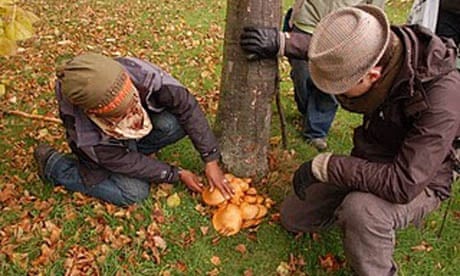Ink caps, jelly ears, yellow cracked boletes, honey fungus, hen of the woods, russulas and shaggy parasols - the list of weird and wonderfully named wild fungi goes on and on.
Foragers in Leeds have been enjoying a bumper crop this autumn, thanks to a wet and humid summer. Filling a basket with wood blewits and boletes has been easy, especially if you spend a few hours in any of Leeds' leafy green spaces like Meanwood Park or Woodhouse Moor.
You may get inquisitive looks from strangers as you poke under hedgerows, scratch about the leaf litter and crane your neck inspecting the trunks of tall oaks, but you'll be rewarded with unusual species that taste completely different from the cultivated mushrooms that can be bought in plastic-wrapped packs at Tesco or Sainsbury's.
I became wild about mushrooms earlier this year after going on a Food for Free walk in Meanwood Park with the professional forager Mina Said-Allsopp.
Mina is a PhD student at Leeds University, and has been running foraging walks in her spare time for three years. She teaches people how to identify edible greens, mushrooms, berries – just about every form of wild food.
"Foraging makes you see the world with completely different eyes," she says. "It completely challenges your perceptions of what you can eat."
Weirdest wild mushrooms
On my first walk with Mina, she introduced me to one of the weirdest wild mushrooms you can find, chicken of the woods – a lurid-yellow mushroom that oozes out of cracks in trees. It's one of the easiest mushrooms to identify and looks anything but edible; but it has an almost identical taste and texture to real chicken. Amazing stuff.
Mina's passion is contagious. Since that first walk, I've been on a foraging weekend, another wild food walk for my birthday, and even set up my own blog, Absolutely Fungulous; a style-guide to wild mushrooms, which includes an interview with the hot-tempered celebrity chef, Marco Pierre White. He spoke to me about his love for foraging and wild mushrooms; and how he used to go hunting for mousserons (or fairy ring mushrooms) in the stately grounds of Harewood House as a boy.
Of course, the thing that deters most people from picking wild mushrooms is that it can be a very dangerous hobby. The author Nicholas Evans made headline after he poisoned himself and guests by confusing a deadly species of wild mushrooms with an edible one. They all survived, but needed kidney dialysis to deal with the toxins.
A very dangerous hobby
And now, because of the resurgence in the popularity of foraging, more people are carelessly making mistakes: the number of hospital admissions for people with suspected mushroom poisoning has doubled in the past year. In September, the Health Protection Agency's National Poisons Information Service reported that they had received "209 calls from NHS staff attempting to treat suspected mushroom poisoning – a steep rise on last year's 123 enquiries and the 147 in 2008".
I recently interviewed a man called Richard Eshelman for the Guardian Weekend magazine who accidentally ate some of the most poisonous wild mushrooms on the planet. He confused small destroying angels with edible shaggy ink caps. It's a mistake that nearly cost him his life.
Destroying angels attack your liver and there is no known antidote. Sixty to 80% of people who eat them do not survive. Richard, luckily, did survive, but he was hours away from needing a liver transplant and did permanent damage to his kidneys.
Horror stories
Horror stories like these can put people off from ever venturing into the world of foraging and eating wild mushrooms, which is unfortunate. The most important thing is to always thoroughly identify anything you find and to never eat anything if you aren't 100% sure of what it is. Eshelman admits his mistake was being in a rush and not taking the time to properly identify the wild mushrooms he ate.
A good mushroom identification book will tell how certain mushrooms only grow in association with certain trees, whether they can be confused with other species; and that you have to look at things like cap size, spore print and stem length to make an accurate identification.
Autumn may be the best time of the year to find mushrooms, but there are ones that can be found all year round: chanterelles can survive a freezing winter; morels and St George's mushrooms come up in spring; and summer look out for that neon yellow chicken of the woods.
If you're careful and feeling adventurous, it's definitely a risk worth taking.
Sophie Haydock runs her own blog, Absolutely Fungulous; a style-guide to wild mushrooms

Comments (…)
Sign in or create your Guardian account to join the discussion